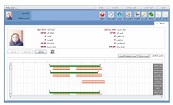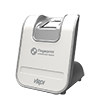The integration of biometrics with time and attendance systems is leading to the rise in biometric data collecting in the workplace. Many modern time and attendance systems have the ability to record employee time using a fingerprint, palm, iris, or facial scan.
Introduction to Biometric Time Attendance Systems
In today's fast-paced world, organizations need efficient and secure ways to monitor employee attendance and manage access control. Biometric time attendance systems have revolutionized workforce management by replacing traditional methods like punch cards and manual entry systems. These advanced devices use biological features such as fingerprints, facial scans, or iris patterns to verify employee identities. By implementing biometric time attendance devices, businesses can streamline operations and ensure accurate tracking of work hours.
What are biometric time and attendance systems?
Keeping track of staff and their time can be difficult, especially when sometimes it's not a primary aspect of your role. Knowing when your staff has got into the office and when they leave is always important in HR(human resources) when there are problems. Biometric time and attendance systems have brought the more precise system to measure group or individual's activities and attendance as well. A biometric time and attendance system will record the clocking in and clocking out of your staff during their working day, and our staff will not need ID cards.
Which types of companies use biometric time clocks?
In theory, biometric time clocks can be used by any company with the necessary money and requirement. Companies in areas such as restaurants, hotels, and hospitals, according to one top maker of fingerprint-based biometric time clocks, comprise up the bulk of biometric time clock clients.
How do biometric time attendance systems work?
Using a biometric time attendance system is becoming increasingly common in corporate and public security systems. A biometric time attendance machine captures your unique biological/physical feature such as your hand or fingerprint, face, iris pattern, hand palm, and sometimes even your voice as a record for identity verification. It allows you to perform something that you are authorized to do.
For example, biometric time and attendance systems use the fingerprints of employees to verify who is clocking in and clocking out of work each day. The fingerprint time attendance machine scans the employee's finger, coordinates are determined, and then the system maps the endpoints and intersections of the fingerprint. The next time the employee uses the touch screen on the biometric system to clock in or out, the coordinates on file are matched with the fingerprint on the screen to verify the employee's identity. If an employee does not register into the time attendance machine, they will not be able to use the biometric system to clock in and out of work each day.
How does biometric technology improve employee time management?
The increasing popularity of biometrics-based systems for time and attendance machines has many benefits because of the biometrics system's capability to recognize unique physiological characteristics(such as fingerprint, voice pattern, hand palm, face shape, or Iris); biometrics technology work entirely for employee time management. On the other hand, this ensures every employee clocks in for their time, not for someone else.
Benefits of a biometric time & attendance system
- It has many advantages over conventional time tracking used at organizations. Typically such organizations maintain a register book, where people enter their name, time in, time out, and other required details, but the problem with this manual system is inaccuracy, time-consuming, unreliable, and most important is less secure.
- Biometric time attendance is very user friendly and easy to use; any person can use it very quickly. It is swift; also, the user has to see once in front of the system, and all details, including its time, will be recorded automatically. In this way, it saves a lot of time and still records details very accurately. We can avoid early punching, late punching, and buddy punching very easily.
- Many schools and colleges use biometric time attendance to track their student's attendance. The biggest advantage of a biometric time attendance machine over manual tracking is the best security. Many shops and shopping malls use biometric access control systems for security purposes, which works a lot.
- If you want to use a biometric time attendance system for business or organization, they can easily integrate into payroll systems, account systems, and billing systems. So in that way, it is very flexible. Besides, it shows that time attendance machines can use for businesses and organizations with great flexibility.
- Biometric time attendance systems are reliable technology to ensure the accuracy of attendance and are useful to those dealing with a large number of employees. In a nutshell, biometric time attendance solutions permit you to focus on your core business by giving the quickest and easiest way to overcome your time tracking issues.
- Biometric time attendance system is a foolproof technology to ensure the accuracy of attendance and is useful to the ones who deal with a large number of employees. In a nutshell, biometric time attendance solutions permit you to focus on your core business by giving the quickest and easiest way to overcome your time tracking issues.
Streamlining Attendance Tracking
Biometric time attendance devices offer a seamless, automated process for recording when employees start and finish their workday. This eliminates the need for manual timesheets and significantly reduces administrative overhead. Employees clock in using their unique biometric data, which ensures accuracy and prevents any form of time theft or buddy punching.
Increasing Accuracy and Reducing Errors
Manual systems are prone to human errors such as data entry mistakes or misplacing attendance records. Biometric systems, however, use precise recognition algorithms that capture real-time attendance without any possibility of inaccuracies. These devices are highly reliable and ensure error-free reporting, making them ideal for large organizations with multiple employees.
Time and Cost Savings
By automating the attendance tracking process, companies can save valuable time that would otherwise be spent managing attendance data manually. This also reduces payroll errors, as employees are paid based on actual working hours captured by the system. Additionally, integrating time attendance devices with payroll software minimizes payroll processing time, ensuring on-time salary distribution and boosting overall productivity.
Enhancing Employee Productivity
Biometric systems not only streamline time tracking but also improve overall efficiency by providing detailed data on employee attendance patterns. Managers can easily monitor punctuality, track absences, and ensure fair attendance policies. Furthermore, automated systems give employees accountability, leading to increased workplace discipline and productivity.
Types of Biometric Authentication
Different types of biometric recognition technologies are used in attendance systems. These include:
Fingerprint Recognition
Fingerprint recognition is one of the most commonly used methods in biometric time attendance devices. Fingerprints are unique to every individual, making it a highly secure form of authentication. Devices such as the Timax Plus Fingerprint Attendance Device offer features like anti-fake fingerprint recognition and fast data processing, making them ideal for both small and large-scale enterprises.
Facial Recognition
Facial recognition systems are increasingly popular due to their contactless nature, which enhances hygiene in workplaces. These systems capture a 3D image of an employee's face and match it against stored data. Devices like the UFace 602 are commonly used in high-security areas, providing accurate identification even in challenging lighting conditions.
Iris and Retina Scans
Iris and retina scanning technologies are known for their high accuracy. These systems capture unique patterns in the employee’s eyes, offering a highly secure way to monitor attendance. While more expensive, these systems are often used in industries where security is paramount, such as defense and financial sectors.
Palm and Vein Recognition
Palm vein recognition is a relatively newer technology, which uses near-infrared light to capture the unique vein patterns in an employee’s hand. This method is highly secure and difficult to forge. Companies with high-security needs often opt for palm vein recognition as it provides both speed and accuracy.
Integration with Access Control Systems
Biometric time attendance devices can also be integrated with access control systems, providing a comprehensive security solution. By combining attendance tracking with access management, businesses can monitor employee movement in real-time and ensure only authorized personnel gain access to restricted areas. Systems like the Virdi AC2100 Plus Access Control not only monitor attendance but also control door access, enhancing workplace security and minimizing the risk of unauthorized entry.
Challenges in Implementing Biometric Systems
While biometric systems offer numerous advantages, they also come with certain challenges. These include:
- High Initial Costs: Biometric devices, especially those utilizing advanced technologies such as iris or palm vein recognition, can be expensive to install.
- Maintenance and Upkeep: Regular calibration and software updates are necessary to keep these systems functioning optimally.
- User Resistance: Some employees may feel uncomfortable using biometric systems due to privacy concerns or unfamiliarity with the technology.
Compliance with Privacy and Data Protection Regulations
One of the critical considerations when implementing biometric time attendance systems is ensuring compliance with local data protection regulations such as GDPR. Companies need to take measures to protect biometric data from breaches and misuse, as this data is considered sensitive. Biometric systems should be designed with encryption and secure storage protocols to safeguard employee information.
Future Trends in Biometric Time Attendance Systems
The future of biometric time attendance systems lies in the integration of AI and cloud technologies. Upcoming trends include:
- AI-Powered Recognition: Artificial intelligence will improve the accuracy of biometric systems by learning and adapting to changing employee characteristics over time.
- Cloud Integration: Cloud-based biometric systems will allow for centralized data management, making it easier for businesses with multiple locations to manage employee attendance.
- Multi-Biometric Systems: Combining multiple biometric methods, such as fingerprint and facial recognition, will further enhance security and reliability.
Conclusion
Biometric time attendance systems are reshaping the way businesses manage employee attendance and access control. By leveraging advanced biometric technologies, companies can streamline operations, reduce costs, and enhance overall security. With future advancements in AI and cloud technologies, biometric systems will become even more integral to workforce management.







































































